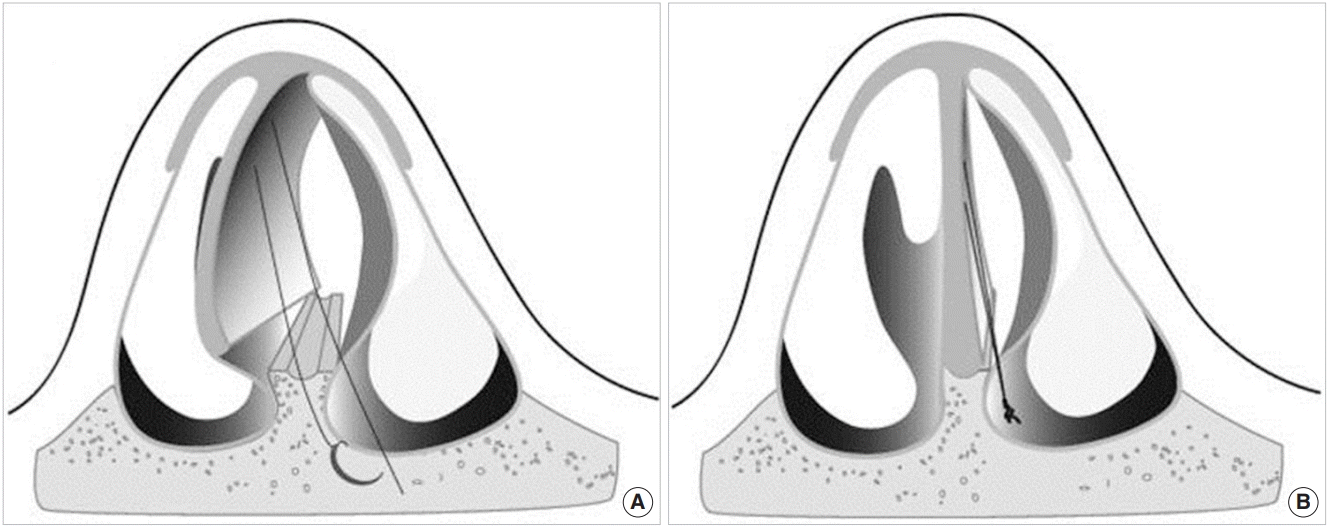1. Killlan G, Foster EE. The submucous window resection of the nasal septum. Ann Otol Rhinol Laryngol. 1905; Jun. 14(2):363–93.
2. Murakami WT, Wong LW, Davidson TM. Applications of the biomechanical behavior of cartilage to nasal septoplastic surgery. Laryngoscope. 1982; Mar. 92(3):300–9.

3. Lee JE, Jung HJ, Chang M, Jin HR. A novel wedge technique to correct the curved deviation of the cartilaginous nasal septum. Auris Nasus Larynx. 2014; Apr. 41(2):190–4.

4. Shin JH, Lee MH, Kim YH, Kim SW, Kim SW, Cho JH, et al. Wedge resection and modified mattress suture for correcting anterior septal deviation: how we do it. Clin Otolaryngol. 2011; Oct. 36(5):504–9.

5. Chung YS, Seol JH, Choi JM, Shin DH, Kim YW, Cho JH, et al. How to resolve the caudal septal deviation? Clinical outcomes after septoplasty with bony batten grafting. Laryngoscope. 2014; Aug. 124(8):1771–6.

6. ten Koppel PG, van der Veen JM, Hein D, van Keulen F, van Osch GJ, Verwoerd-Verhoef HL, et al. Controlling incision-induced distortion of nasal septal cartilage: a model to predict the effect of scoring of rabbit septa. Plast Reconstr Surg. 2003; May. 111(6):1948–57.

7. Gruber RP, Nahai F, Bogdan MA, Friedman GD. Changing the convexity and concavity of nasal cartilages and cartilage grafts with horizontal mattress sutures. Part II: clinical results. Plast Reconstr Surg. 2005; Feb. 115(2):595–606.

8. Heo SJ, Kim JS. Crosshatching incision technique in septoplasty: experimental outcomes under actual surgical settings. Auris Nasus Larynx. 2016; Oct. 43(5):518–23.

9. Jin HR, Lee JY, Jung WJ. New description method and classification system for septal deviation. J Rhinol. 2007; May. 14(1):27–31.
10. Song SH, Nam WH, Kim JS. Anchoring suture for correction of septal deviation. J Rhinol. 2006; Apr. 13(1):18–21.
11. Fry H, Robertson WV. Interlocked stresses in cartilage. Nature. 1967; Jul. 215(5096):53–4.

12. Fry HJ. Interlocked stresses in human nasal septal cartilage. Br J Plast Surg. 1966; Jul. 19(3):276–8.

13. Murray JA. The behaviour of nasal septal cartilage in response to trauma. Rhinology. 1987; Mar. 25(1):23–7.
14. Lopatin AS. Do laws of biomechanics work in reconstruction of the cartilaginous nasal septum. Eur Arch Otorhinolaryngol. 1996; 253(4-5):309–12.

15. Min YG, Chung JW. Cartilaginous incisions in septoplasty. ORL J Otorhinolaryngol Relat Spec. 1996; Jan-Feb. 58(1):51–4.

16. Seo MC, Heo SC, Chung YS, Lee BJ. Overcorrected septums as a complication of septoplasty. Korean J Otolaryngol-Head Neck Surg. 2001; Jun. 44(6):628–32.
17. Yang JW, Kim SI, Kwon JW, Park DJ. Are cross-hatching incisions mandatory for correction of cartilaginous septal deviation. Clin Exp Otorhinolaryngol. 2008; Mar. 1(1):20–3.

18. Lee DC, Jin SG, Kim BY, Yoo S, Han S, Lee YJ, et al. Does the effect of inferior turbinate outfracture persist? Plast Reconstr Surg. 2017; Feb. 139(2):386e–391e.

19. Kim DH, Park HY, Kim HS, Kang SO, Park JS, Han NS, et al. Effect of septoplasty on inferior turbinate hypertrophy. Arch Otolaryngol Head Neck Surg. 2008; Apr. 134(4):419–23.






 PDF
PDF Citation
Citation Print
Print



 XML Download
XML Download